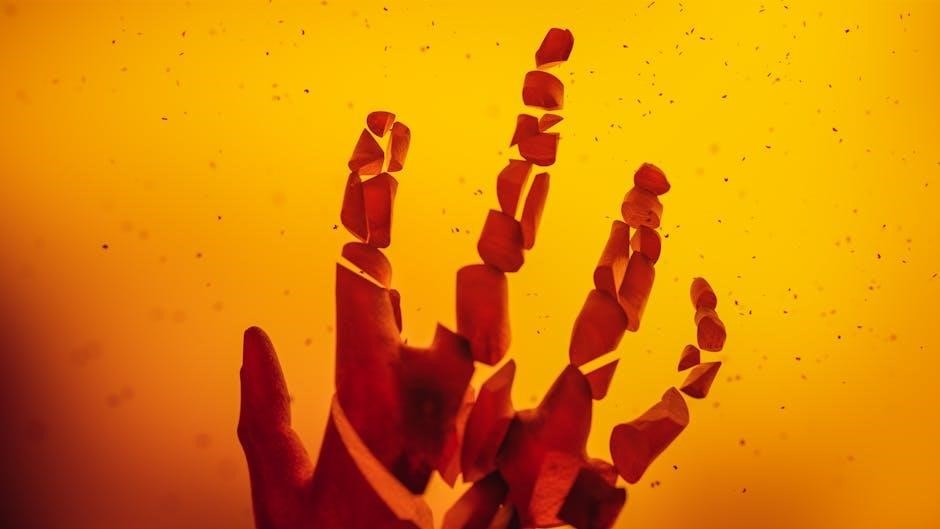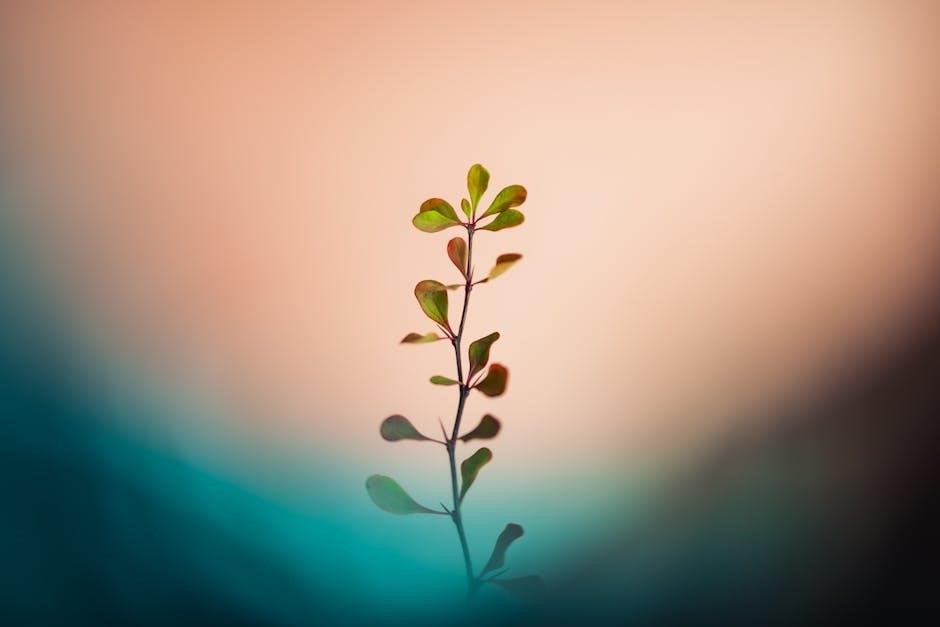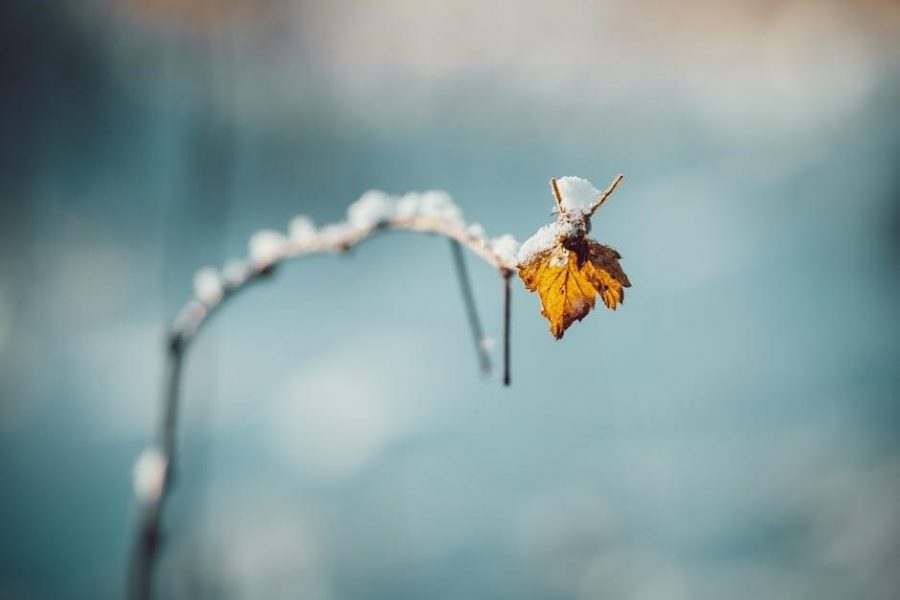Crystal growing is a fascinating process that combines chemistry and patience. It involves preparing a super-saturated solution, allowing crystals to form on a seed. This hands-on experiment teaches chemical principles while producing stunning results. Always follow safety guidelines and instructions carefully for best outcomes.
1.1 What is Crystal Growing?
Crystal growing is a scientific process where a crystal forms from a solution containing the crystal’s dissolved particles. It involves dissolving a chemical in hot water, creating a super-saturated solution, and allowing it to cool. A seed crystal or object is introduced, serving as a nucleation site for crystal formation. Over time, as the solution cools and evaporates, atoms bond to the seed, growing the crystal. This process requires patience and precise conditions. Crystal growing is both educational and rewarding, offering insights into chemistry and geology while producing beautiful, fragile structures.
1.2 Importance of Following Instructions
Following instructions is crucial for successful crystal growing. Proper preparation ensures safety, as chemicals can be hazardous if mishandled. Instructions guide the correct proportions for the solution, essential for crystal formation. Deviating from steps can lead to contamination or failure. Timing and temperature control are critical, as they affect growth rate and quality. Protective gear, like gloves and goggles, must be used to prevent accidents. By adhering to guidelines, you maximize the chances of growing well-formed crystals while learning fundamental scientific principles. This structured approach also enhances the educational value of the experiment.
1.3 Safety Precautions
Safety is paramount when working with crystal growing kits. Always wear protective gear, including gloves and goggles, to prevent chemical exposure. Avoid direct contact with the solution, as it may cause skin irritation. Ensure the workspace is well-ventilated and out of reach of children. Never ingest any substances from the kit, and wash hands thoroughly after handling materials. Follow all instructions carefully to minimize risks. Proper precautions ensure a safe and enjoyable crystal-growing experience while learning about chemical processes and crystal formation.

Materials and Tools Needed
A crystal growing kit typically includes a seed crystal, solution, and growing container. Additional tools like measuring cups, spoons, and gloves are essential. Protective gear is recommended.
2.1 Crystal Growing Kit Components
A crystal growing kit usually includes a seed crystal or rock, crystal powder, and a growing vessel. The kit may also contain a plastic tray, a treated paper tree, or other structures for crystal formation. Some kits provide measuring cups, spoons, and instructions. The crystal powder is the main chemical that dissolves in hot water to create the super-saturated solution; Additional items like a silicon cup or base rock may be included for specific experiments. Always ensure all components are clean and dry before use to promote successful crystal growth. Follow the instructions for proper assembly and preparation.
2.2 Additional Tools Required
Beyond the kit, you’ll need a few household items to ensure successful crystal growth. Scissors are useful for cutting packaging or preparing the seed crystal. A clean kitchen towel is essential for drying the base rock or seed. A stable, flat surface is necessary for placing the growth chamber. For some experiments, gloves and protective eyewear may be recommended to handle chemicals safely. Ensure all tools are clean and dry before use to avoid contamination. These additional items help create the ideal environment for crystal formation and ensure the experiment runs smoothly. Always refer to the instructions for specific requirements.
2.3 Protective Gear
Protective gear is essential for safely handling chemicals and ensuring a successful crystal-growing experience. Gloves are recommended to prevent skin contact with potentially irritating substances. Goggles or safety glasses should be worn to protect eyes from accidental splashes. A lab coat or apron can also be used to avoid staining clothing. These items may not be included in the kit, so it’s important to have them ready. Prioritizing safety ensures a enjoyable and hazard-free experiment. Always handle chemicals with care and keep them out of reach of children and pets to maintain a safe environment.
Preparing the Solution
Dissolve the crystal-growing chemical in boiling water, stirring thoroughly to create a super-saturated solution. Allow it to cool slightly before proceeding to the next steps.
3.1 Measuring and Boiling Water
Begin by measuring 200ml of water using a precise measuring tool. Pour the water into a heat-resistant container and bring it to a boil. Ensure the water reaches its boiling point to effectively dissolve the crystal powder. Once boiling, reduce the heat slightly to maintain a steady temperature. Carefully pour the boiling water into the prepared container for mixing. Always handle boiling water with caution to avoid burns. This step is crucial for creating the super-saturated solution needed for crystal growth.
3.2 Dissolving the Crystal Powder
Gradually add the crystal powder to the boiling water, stirring continuously to ensure even dissolution. Use the provided spoon to measure the exact amount of powder. Avoid overloading the solution, as excess powder will not dissolve and can hinder crystal growth. Continue stirring for about two minutes until the powder is fully dissolved. The solution should appear clear and free of particles. Proper dissolution is essential for achieving a super-saturated solution, which is crucial for crystal formation. Be patient and thorough during this step to ensure optimal results.
3.3 Stirring the Mixture
Stir the mixture thoroughly for about two minutes to ensure the crystal powder dissolves completely. Use the provided spoon or stirrer to mix evenly. Maintain consistent motion to prevent lumps from forming. Avoid splashing the solution. Continue stirring until the mixture is smooth and free of visible particles. Proper stirring ensures a uniform concentration of the solution, which is vital for crystal growth. Once fully dissolved, allow the solution to cool slightly before proceeding to the next step. This step is critical for achieving the right consistency for crystal formation.
3.4 Cooling the Solution
After dissolving the crystal powder, allow the solution to cool slightly. Cover the container to prevent contamination and let it cool to room temperature. Stir occasionally to release heat evenly. Avoid rapid cooling, as it may cause premature crystallization. Once the solution has cooled enough but is still warm, it is ready for the next step. Proper cooling ensures the solution remains supersaturated, which is essential for crystal growth. Be patient, as this step is crucial for achieving optimal results in the crystal-growing process.

Setting Up the Growth Chamber
Place the seed crystal gently into the growth container. Pour the cooled solution over it, ensuring complete immersion. Seal the chamber tightly to prevent evaporation. Position it in a stable, undisturbed environment to allow crystals to form without interference.
4.1 Selecting the Seed Crystal
Selecting the right seed crystal is crucial for successful growth. Choose a clean, dry rock or base from your kit. Ensure it’s free of contaminants and has a rough texture for better crystal adherence. Gently wash with warm water, then dry thoroughly. This preparation enhances nucleation, promoting healthy crystal formation. Handle the seed carefully to avoid damage, as it serves as the foundation for your growing crystal. Avoid touching the seed with bare hands to prevent oil transfer, which can hinder growth.
4.2 Placing the Seed Crystal
Gently place the prepared seed crystal into the growth chamber, ensuring it is centered and stable. Avoid touching the crystal with bare hands to prevent transferring oils. Position the seed so it doesn’t obstruct the solution flow. If using a string or clip, attach it securely to suspend the crystal, allowing even growth; Ensure the seed is fully submerged in the solution but not touching the container’s sides or bottom. Proper placement promotes balanced crystal formation and prevents irregular growth patterns. Handle the chamber carefully after placement to avoid disturbing the setup.
4.3 Adding the Solution
Carefully pour the prepared solution into the growth chamber, ensuring it covers the seed crystal completely. Avoid spilling or splashing to maintain a clean environment. Pour slowly to prevent air bubbles from forming, which can disrupt crystal growth. If using a pouring spout or funnel, align it with the chamber’s opening for precise flow. Once the solution is added, double-check that the seed remains submerged. Any excess solution can be gently removed with a clean cloth or paper towel. Properly adding the solution sets the stage for optimal crystal formation and minimizes contamination risks.
4.4 Sealing the Chamber
Once the solution is added and the seed crystal is properly placed, seal the chamber tightly to prevent contamination and evaporation. Ensure the lid is securely fastened or, if using plastic wrap, stretch it tightly over the opening and secure with a rubber band. A proper seal helps maintain the solution’s concentration and promotes undisturbed crystal growth. Double-check for any gaps or leaks to ensure the chamber is airtight. Sealing the chamber is crucial for creating a stable environment that fosters crystal formation without external interference.
4.5 Positioning the Chamber
Place the sealed chamber on a stable, flat surface away from direct sunlight and heat sources. Ensure the chamber is level to maintain an even solution distribution. Avoid areas prone to vibrations or movement, as this could disrupt crystal growth. Positioning the chamber correctly ensures undisturbed crystal formation. Once placed, do not move the chamber until crystal growth is complete. This step is crucial for allowing the solution to settle and crystals to form without interference. Proper positioning supports optimal growth conditions.
Observing Crystal Growth
Observe crystals regularly without disturbing the setup. Note growth patterns, colors, and shapes. Document changes to track progress and identify factors influencing crystal development. Stay patient and consistent.
5.1 Expected Timeline
The crystal growth timeline varies, but initial formation typically begins within 1-3 days. Significant growth is noticeable within 7-14 days. For larger crystals, allow 2-4 weeks. Keep the environment stable and avoid disturbing the setup. Factors like temperature and solution concentration can speed up or slow down the process. Be patient and monitor regularly to ensure optimal conditions for crystal development. Documenting daily changes helps track progress and understand the growth pattern more effectively. Consistency and patience are key to achieving impressive results.
5.2 Factors Affecting Growth
Temperature, solution concentration, and environmental stability significantly influence crystal growth. Higher temperatures can accelerate growth but may lead to imperfections. A super-saturated solution is crucial for crystal formation. Disturbances, such as vibrations or movement, can disrupt growth. Maintaining a consistent environment, including humidity levels, is essential. Impurities in the solution or on the seed crystal can hinder growth or cause defects. Monitoring these factors helps achieve optimal results. Patience and careful observation are key to understanding how these variables interact and impact the final crystal structure. Adjustments may be needed to refine the process for better outcomes.
5.3 Documenting Progress
Documenting the crystal growth process is essential for understanding and improving results. Take photos or videos daily to track changes and measure growth rates. Record observations, noting temperature, solution clarity, and any visible changes. Keep a journal to log the timeline, solution composition, and environmental conditions. This documentation helps identify patterns and refine techniques. Sharing progress with others can also provide insights and tips. Regular updates allow for early detection of issues, ensuring optimal crystal formation. This practice fosters scientific inquiry and enhances the learning experience, making it a valuable part of the crystal-growing process. Consistency is key for accurate tracking and analysis.
Post-Growth Steps
Once crystals have fully formed, carefully remove and rinse them with distilled water. Clean the growth chamber thoroughly and let it dry. Store the crystal safely to preserve its structure and clarity for display or further study.
6.1 Harvesting the Crystal
Once the crystal has fully formed, carefully remove it from the growth chamber using clean, dry gloves or tweezers to avoid damaging it; Gently rinse the crystal with distilled water to remove any residual solution. Handle the crystal with care, as it may be fragile. Place it on a paper towel or soft cloth to dry completely. Avoid touching the crystal excessively, as oils from your skin can dull its surface. Store the harvested crystal in a dry, secure location to preserve its clarity and structure for display or further observation.
6.2 Cleaning the Equipment
After harvesting your crystal, thoroughly clean all equipment to prepare for future use. Wash the growth chamber, containers, and utensils with warm water and mild soap. Rinse everything meticulously to remove any residue from the solution. Avoid using harsh chemicals or abrasive materials that could damage the equipment. Dry each item completely to prevent water spots or mineral deposits. Regular cleaning ensures the equipment remains in good condition and ready for subsequent crystal-growing experiments. Always wear gloves during this process to maintain cleanliness and safety.
6.3 Storing the Crystal
Once your crystal is harvested, handle it carefully to avoid damage. Gently rinse it with distilled water to remove any residual solution; Pat it dry with a soft cloth or paper towel to prevent water spots. Store the crystal in a cool, dry place away from direct sunlight, which can cause discoloration. Place it in a protective case or airtight container to maintain its integrity. For long-term preservation, avoid exposure to moisture or extreme temperatures. Proper storage ensures your crystal remains a vibrant and lasting result of your experiment.

Additional Experiments
Explore different solutions, supercooling techniques, and environmental factors to observe varying crystal formations. These experiments enhance understanding of crystal growth dynamics and its chemical principles creatively.
7.1 Trying Different Solutions
Experimenting with different solutions can yield varied crystal formations. Try using Epsom salt, copper sulfate, or food coloring to alter crystal properties. Adjust solute concentration to observe changes in size and shape. Environmental factors like temperature can also influence growth patterns. For instance, higher temperatures may produce larger crystals, while lower temperatures can create smaller, more delicate structures. Adding a few drops of food coloring can tint the crystals, enhancing their visual appeal. Additionally, exploring how additives affect the solution’s viscosity and crystal growth rate can provide further insights. Documenting these variations helps understand how different conditions affect crystal growth dynamics and appearance.
7.2 Supercooling the Solution
Supercooling involves cooling a solution below its freezing point without crystallization occurring. This technique can create larger, more transparent crystals. To supercool, prepare the solution as usual, then slowly cool it while avoiding disturbance. Once cooled, carefully introduce a seed crystal to initiate growth. The supercooled state allows molecules to form larger, more ordered structures. This method requires patience, as it can take longer for crystals to form. The result is often fewer but larger crystals with unique shapes and clarity. Experimenting with supercooling adds an exciting dimension to crystal growing, offering insights into how temperature affects crystal formation and structure.
7.3 Exploring Environmental Factors
Environmental factors significantly influence crystal growth. Experimenting with temperature, humidity, and vibrations can reveal how these conditions affect formation. Place the growth chamber in different locations to observe variations in crystal shape and size. A stable, vibration-free environment often yields larger, clearer crystals, while temperature fluctuations can create unique patterns. Humidity levels may also impact growth rates. By testing these variables, you can gain insights into how external conditions shape crystal formation. This exploration adds an educational dimension to the process, encouraging observation and curiosity about the interplay between environment and crystal development;

Troubleshooting Common Issues
Common issues include no crystal formation, slow growth, or imperfections. Check solution preparation, temperature, and seed placement. Ensure proper mixing and avoid contamination for optimal results.
8;1 No Crystal Formation
If no crystals form, check the solution preparation. Ensure the correct amount of powder was dissolved in boiling water and stirred thoroughly. Verify the seed was properly placed and the chamber sealed. Temperature fluctuations or contamination can hinder growth. Allow sufficient time for crystals to develop, as growth is slow. If issues persist, recheck instructions and ensure all steps were followed accurately. Patience and precise preparation are key to successful crystal formation.
8.2 Slow Growth Rate
If crystal growth is slow, ensure the solution was properly prepared with the correct amount of powder dissolved in boiling water. Verify the seed is submerged and undisturbed. Check that the chamber is sealed to maintain a consistent environment. Slow growth may result from insufficient supersaturation or temperature fluctuations. Allow more time, as crystals often grow gradually. If necessary, gently reheat the solution or ensure the seed is free from contaminants. Patience is key, as optimal conditions and time are essential for crystal development to accelerate naturally;
8.3 Imperfections in Crystals
Imperfections in crystals can occur due to impurities in the solution, uneven cooling, or physical disturbances during growth. To minimize defects, ensure the solution is free from contaminants and the seed crystal is clean. Avoid touching the crystal or moving the chamber excessively, as this can disrupt the growth process. Maintaining a stable environment and allowing sufficient time for growth can help produce more flawless crystals. If imperfections persist, consider filtering the solution or starting with a new seed crystal. Attention to detail and careful handling are key to achieving high-quality crystal formations.
Crystal growing is a rewarding experiment that combines chemistry, patience, and observation. By following the instructions and maintaining a stable environment, you can successfully grow crystals and learn about solubility, nucleation, and geological processes. This activity is both educational and enjoyable, offering insights into scientific principles while producing beautiful crystals. Experimenting with different solutions and conditions can further enhance your understanding and results. Remember, crystal growth is a slow process that requires careful attention to detail. With persistence, you’ll be able to create stunning crystals and appreciate the beauty of chemical reactions.
